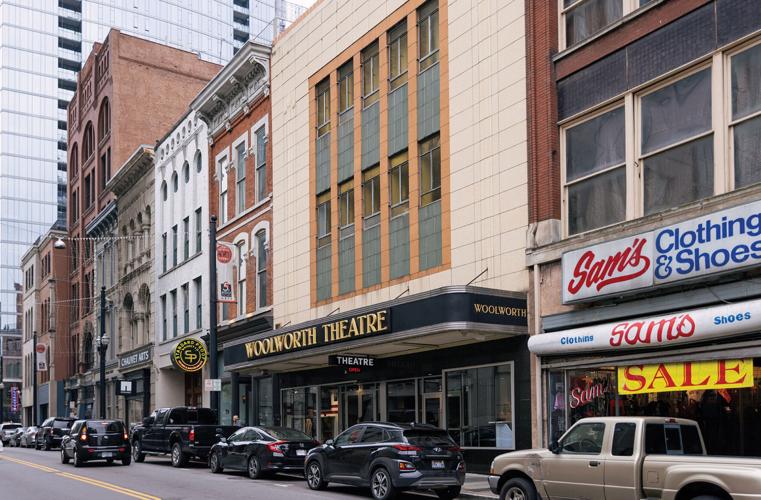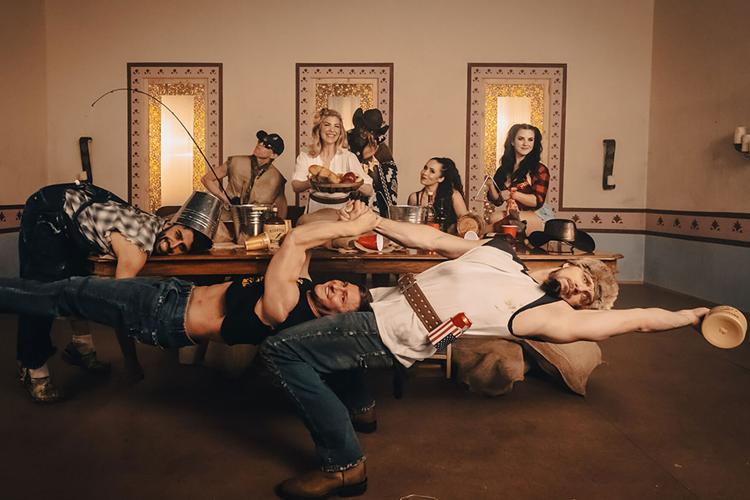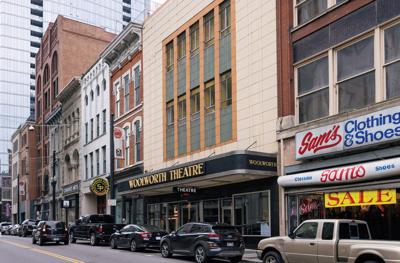In 2021, Historic Nashville Inc. included the Woolworth building downtown on its annual Nashville Nine, a list of historic sites the preservationist group considers at risk of being lost. At the time HNI wrote: “We recommend that they bring in [an expert] with a specialization in the Civil Rights Movement or Black Freedom Struggle, a trained historic preservationist, and a conservator who can assist with the identification and care of the building’s remaining historic elements. Sometimes, historic preservation encompasses not only a building’s exterior but also respect for the interior where historic events took place.”
Were it not for what happened at the Woolworth in February 1960, the building at 221-223 Rep. John Lewis Way N. likely wouldn’t have made the list. Around the time of his 20th birthday, activist and future U.S. Rep. John Lewis was arrested for the first time in what would become a career of civil disobedience. The Nashville sit-ins — nonviolent on the part of the protesters, although not always by those who opposed them — were a crucial turning point in the national civil rights movement and led to integration of the city’s lunch counters, making Nashville the first city in the South to do so.
In 2020, the Metro Council voted to rename Fifth Avenue — the street on which the building sits — Rep. John Lewis Way. At the time, Councilmember Freddie O’Connell tweeted in support: “The world needs #GoodTrouble right now,” a reference to Lewis’ famous mantra.
But recently, the trouble at the Woolworth building has not been good. Last month it was the site of the premiere of The Greatest Lie Ever Sold: George Floyd and the Rise of BLM, a film directed by Candace Owens for far-right website The Daily Wire. Ye — the artist born Kanye West — attended the premiere, attracting the attention of national media, including Billboard, TMZ and Rolling Stone. Also this fall, the new Woolworth Theatre became home to Shiners, an ongoing theatrical show that some critics say includes insensitive content at odds with the building’s history.
“It is kind of sacrilege — it breaks my heart,” says Bruce Bouton, a well-known session musician and a minor investor in the Woolworth building. “The juxtaposition between John Lewis and Kanye is disappointing. The people who let this happen are not working in the spirit of the civil rights movement. Everybody had really high hopes for this property.”
In December 2015, the Woolworth building was purchased for $3.4 million by a trust headed by Fresh Hospitality’s Mike Tidwell. Nashville restaurateur Tom Morales and others turned the bottom two floors — which once operated as a Dollar General — into Woolworth on Fifth, a restaurant designed to engage tourists and locals about the sit-ins and their role in Nashville’s history.
Woolworth on Fifth opened in 2018 after a $6 million renovation. Working with architecture firm Tuck-Hinton, the team uncovered the original mezzanine with metal railings and terrazzo floors. They created a replica of the historic lunch counter and found three of the original stools from the sit-in era. The team also found a water fountain with a “Blacks only” sign and other painful artifacts from segregation. They worked with the Nashville Public Library for permission to use archival photos and video footage to tell the stories of the sit-in movement at the restaurant.
The Woolworth on Fifth project fit with other efforts to tell a fuller story of Nashville’s past, not erasing the Music City moniker, but showing that the city’s past is not one-note.
“Those stores were sacred ground,” says Lee Sentell, founder of the U.S. Civil Rights Trail, which launched in 2018. The trail helps Southern states make their civil rights landmarks more accessible to students, locals and tourists. In 1983 the Woolworth building was one of 28 structures included as part of an application for Fifth Avenue Historic District status; the building was awarded that status as part of the group, not on its own. That paperwork notes the 1890s structure’s exterior terracotta panels and the interior mezzanine. In many cities, the buildings on the trail are now gone.
“It is hard to go to Atlanta and find even one civil rights building still standing,” says Sentell. “In Nashville, I’m impressed that the buildings are still there. Our job is to put a spotlight on these places and hope that the property owners have successful businesses so that the buildings won’t get bulldozed.”
The reasons the Woolworth on Fifth restaurant eventually closed are myriad. Morales, who remembers shopping at Woolworth as a child, sold his stake in 2019 before it was shuttered. The space then was leased to the team that developed the Woolworth Theatre: Woolworth Theatre CEO and country music artist Chuck Wicks, Joe Bravo, and local technology entrepreneur Rob Bellenfant and his 615 Ventures investment firm. Wicks and Bravo declined repeated requests for an interview for this article. Bellenfant did not return multiple messages, nor did Tidwell or other major investors in the building. The Woolworth Theatre did share a statement on social media, however, noting that it is “a place where everyone is welcome,” and that “the Woolworth Theatre does not comment on the functions, content, or the guest lists of our clients for private events.”
In March 2022, the building unveiled an exterior display window featuring one of the original lunch counter stools, one of Lewis’ iconic trench coats, and books and video about the sit-in era. Then-CEO Keval Sheth underscored the team’s commitment to paying homage to the building’s past. (Sheth has since left the Woolworth Theatre leadership team for personal reasons.)
As part of the process to turn the space into a theater, the replica lunch counter was removed, and the terrazzo flooring has been covered, though it is still visible in some landings and hallways. The mezzanine railings remain intact and visible and are encased to protect them as part of everyday use. The building’s upper floors, called Woolworth Upstairs, include 12 Airbnbs that opened in 2019 and are unaffiliated with the theater.
While he is no longer a stakeholder, Morales is frustrated that the historic — and expensive — work that went into the space wasn’t protected as it was remodeled for its next act. “It is disrespecting the history of the first place John Lewis was arrested,” he says.
In addition to the physical space, at issue is Shiners, a show Wicks spent more than four years developing, inspired by Absinthe, an adults-only show in Las Vegas. (If readers want to see Shiners and be surprised by its acts, consider this a spoiler alert.) Shiners is billed as a Vegas-meets-Broadway (as in Lower Broad, not the Great White Way) show about a moonshiner family reunion. The show features Wicks — who, as it happens, is the brother-in-law of conservative country music star Jason Aldean — and Laura Osnes, a Tony Award nominee who spends part of the evening sitting on a trapeze swinging above the audience.

Shiners
While Wicks and Osnes sing some, and Wicks plays the guitar, Shiners is largely accompanied by prerecorded pop music. Performers roam through the room and rows of folding chairs as audience members grab drinks from the bar, located where the historic lunch counter used to be. Throughout the 75-minute show, they perform Cirque du Soleil-style acts, including gravity-defying acrobatics, pole dancing and contortion. Given the moonshine theme and the bickering-family shtick, the show has the feel of Pigeon Forge dinner theater — if Pigeon Forge allowed a lot more sexual innuendo. In one scene, three male performers arrive onstage seemingly naked and slide towels back and forth, carefully keeping their privates private. A spotlight moves from man to man, bigger on one than the other, implying varying penis sizes.
The heart of Shiners is the incredible athleticism of the performers, rather than a narrative thread. But the hard-to-follow connections between the characters have led to some concern. At one point, two male performers drink moonshine that is a love potion, causing them to become infatuated and leading to an astonishing acrobatic duet. The playbill doesn’t clarify whether their characters, Jim Bo Shiner and Bo Bo Shiner, are related to each other. Are they meant to be brothers or cousins? It might not seem like it matters, but the idea of them being in love with each other is treated as unseemly, which is jarring. Context on why audiences are supposed to find their attraction problematic would be helpful.
Later in the evening, six audience members are called onstage to play Family Feud, complete with theme music and an LED-screen backdrop. They are asked what animal noise people are most likely to make in bed, leading to a cacophony of sound. Eventually, Michael Tumelo Moloi, the only Black member of the cast, appears in a vaguely tribal costume and makes melodious animal noises. Moloi is internationally known for his traditional African dance performances, and this information is included in his artist bio, but context for why the dance is taking place at the Shiner reunion is not.
Moloi’s non-speaking role, combined with the dance and his face paint, is one that many audience members have found racially insensitive and disconnected from the racial history that took place on the property. Moloi did not respond to interview requests. The show’s title refers to the family of moonshiners, but critics have noted that the term “shiner” also has historical negative connotations, sometimes having been used as a derogatory term for Black people. If all of this were taking place elsewhere, say in a tent outside Caesar’s Palace in Las Vegas like Absinthe, it likely would have gone unremarked upon. But the disconnect between the content and the historical significance of the space has many people troubled.
The Nashville Convention & Visitors Corp suspended the Woolworth Theatre’s membership after receiving numerous comments and complaints about the content of Shiners. Butch Spyridon, CEO of the NCVC, emphasizes that the organization is not interested in policing what content is or is not performed in Nashville. He was concerned, however, that many people were unaware that the show was adults-only. Some early promotional materials did not specify the audience for the show; newer posters have 18-and-up information added. Early criticisms came from audience members who were surprised by the ribald nature of the comedy. The NCVC is waiting to hear back from the Woolworth Theatre team about possible changes that may be made to the show to set clear expectations about its content and to put the story in context.
Of course, not everyone is aghast. Many ticketholders have loved Shiners, particularly the impressive athleticism of the performers, the vaudeville-like pacing and energy, the adults-only humor, and the opportunity to engage with the cast.
“Not only is the space important, but it needs to be a place where you know about the story of the building before you see a show there,” says Carole Bucy, Davidson County historian. At present, during Shiners there’s no explanation of what the space is or why it’s important. There’s nothing included in the playbill, and no one makes a preshow announcement about the education window in front. Such land acknowledgements are increasingly commonplace. For example, an announcement may be made before the curtain rises about the Indigenous peoples who once owned the land on which a theater is built.
Spyridon understands that historical significance alone doesn’t pay a mortgage, and that there has to be a way to generate revenue to keep a building open. He hopes that everyone involved will demonstrate “respect for the building. Woolworth is the cradle of our civil rights efforts.”
To generate revenue, the theater is renting space to other productions, and not all come with the baggage of Owens’ film. Last week a live music show featuring female singer-songwriters called She Believed She Could opened for what producers hope will be a long run.
“We’re proud to be launching a family-friendly show that celebrates the women of country music,” says Todd Cassetty, director and producer of She Believed She Could. “We’re excited to be downtown in a building where history was made fighting for inclusion and empowerment. Those are themes that are reinforced in our production.”
Those who want to see Nashville’s civil rights legacy as a visible part of its identity hope commerce and conservation can coexist.
“We are losing the historic fabric of Nashville,” says Bucy. “The very least we can do is save the stories before we don’t have anything left.”







